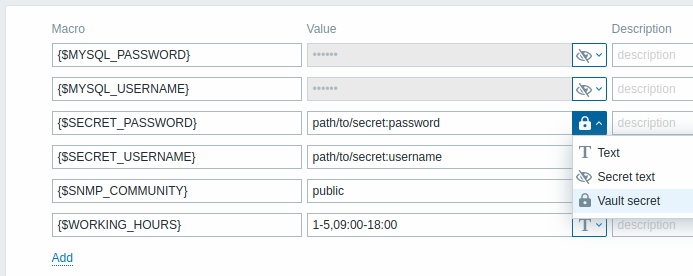Is this not what you were looking for? Switch to the current version or choose one from the drop-down menu.
2 User macros
Overview
User macros are supported in Zabbix for greater flexibility, in addition to the macros supported out-of-the-box.
User macros can be defined on global, template and host level. These macros have a special syntax:
Zabbix resolves macros according to the following precedence:
- host level macros (checked first)
- macros defined for first level templates of the host (i.e., templates linked directly to the host), sorted by template ID
- macros defined for second level templates of the host, sorted by template ID
- macros defined for third level templates of the host, sorted by template ID, etc.
- global macros (checked last)
In other words, if a macro does not exist for a host, Zabbix will try to find it in the host templates of increasing depth. If still not found, a global macro will be used, if exists.
If a macro with the same name exists on multiple linked templates of the same level, the macro from the template with the lowest ID will be used. Thus having macros with the same name in multiple templates is a configuration risk.
If Zabbix is unable to find a macro, the macro will not be resolved.
Macros (including user macros) are left unresolved in the Configuration section (for example, in the trigger list) by design to make complex configuration more transparent.
User macros can be used in:
- item key parameter
- item update intervals and flexible intervals
- trigger name and description
- trigger expression parameters and constants (see examples)
- many other locations - see the full list
Common use cases of global and host macros
- use a global macro in several locations; then change the macro value and apply configuration changes to all locations with one click
- take advantage of templates with host-specific attributes: passwords, port numbers, file names, regular expressions, etc.
Configuration
To define user macros, go to the corresponding location in the frontend:
- for global macros, visit Administration → General → Macros
- for host and template level macros, open host or template properties and look for the Macros tab
If a user macro is used in items or triggers in a template, it is suggested to add that macro to the template even if it is defined on a global level. That way, if the macro type is text exporting the template to XML and importing it in another system will still allow it to work as expected. Values of secret macros are not exported.
A user macro has the following attributes:

| Parameter | Description |
|---|---|
| Macro | Macro name. The name must be wrapped in curly brackets and start with a dollar sign. Example: {$FRONTEND_URL}. The following characters are allowed in the macro names: A-Z (uppercase only) , 0-9 , _ , . |
| Value | Macro value. Three value types are supported: Text (default) - plain-text value Secret text - the value is masked with asterisks Vault secret - the value contains a path/query to a vault secret. To change the value type click on the button at the end of the value input field. Maximum length of a user macro value is 2048 characters (255 characters in versions before 5.2.0). |
| Description | Text field used to provide more information about this macro. |
In trigger expressions user macros will resolve if referencing a parameter or constant. They will NOT resolve if referencing a host, item key, function, operator or another trigger expression. Secret macros cannot be used in trigger expressions.
Examples
Example 1
Use of host-level macro in the "Status of SSH daemon" item key:
net.tcp.service[ssh,,{$SSH_PORT}]
This item can be assigned to multiple hosts, providing that the value of {$SSH_PORT} is defined on those hosts.
Example 2
Use of host-level macro in the "CPU load is too high" trigger:
last(/ca_001/system.cpu.load[,avg1])>{$MAX_CPULOAD}
Such a trigger would be created on the template, not edited in individual hosts.
If you want to use the amount of values as the function parameter (for example, max(/host/key,#3)), include hash mark in the macro definition like this: SOME_PERIOD => #3
Example 3
Use of two macros in the "CPU load is too high" trigger:
min(/ca_001/system.cpu.load[,avg1],{$CPULOAD_PERIOD})>{$MAX_CPULOAD}
Note that a macro can be used as a parameter of trigger function, in this example function min().
Example 4
Synchronize the agent unavailability condition with the item update interval:
- define {$INTERVAL} macro and use it in the item update interval;
- use {$INTERVAL} as parameter of the agent unavailability trigger:
nodata(/ca_001/agent.ping,{$INTERVAL})=1
Example 5
Centralize configuration of working hours:
- create a global {$WORKING_HOURS} macro equal to
1-5,09:00-18:00; - use it in the Working time field in Administration → General → GUI;
- use it in the When active field in Administration → User → Media;
- use it to set up more frequent item polling during working hours:

- use it in the Time period action condition;
- adjust the working time in Administration → General → Macros, if needed.
Example 6
Use host prototype macro to configure items for discovered hosts:
- on a host prototype define user macro {$SNMPVALUE} with {#SNMPVALUE} low-level discovery macro as a value:

- assign Generic SNMPv2 template to the host prototype;
- use {$SNMPVALUE} in the SNMP OID field of Generic SNMPv2 template items.
